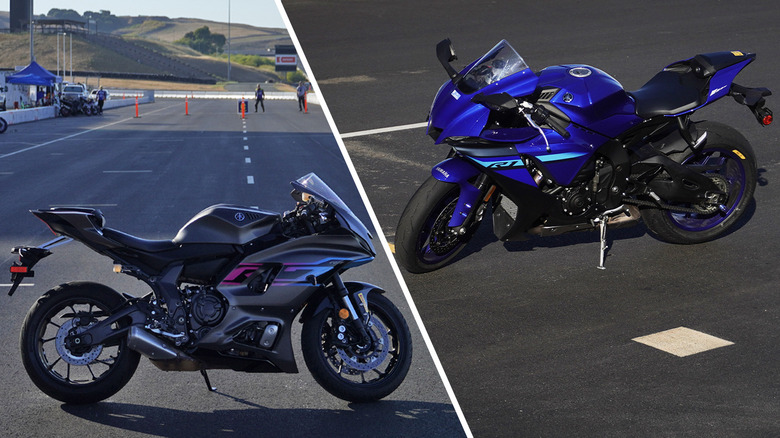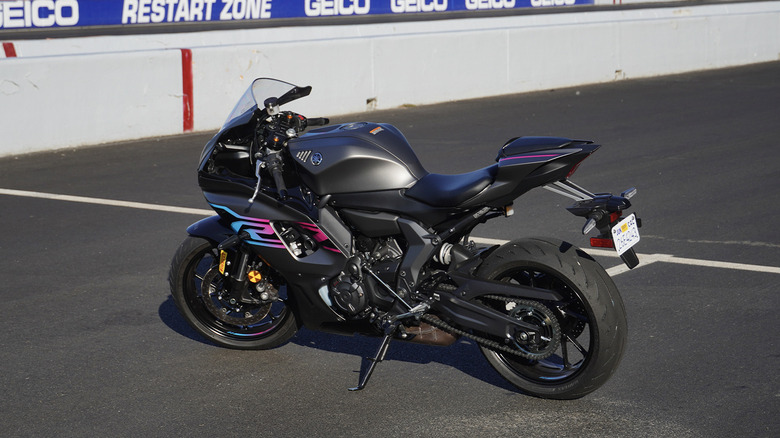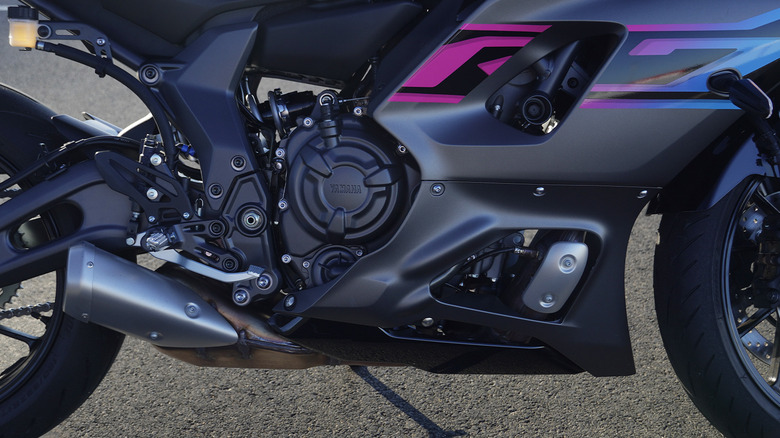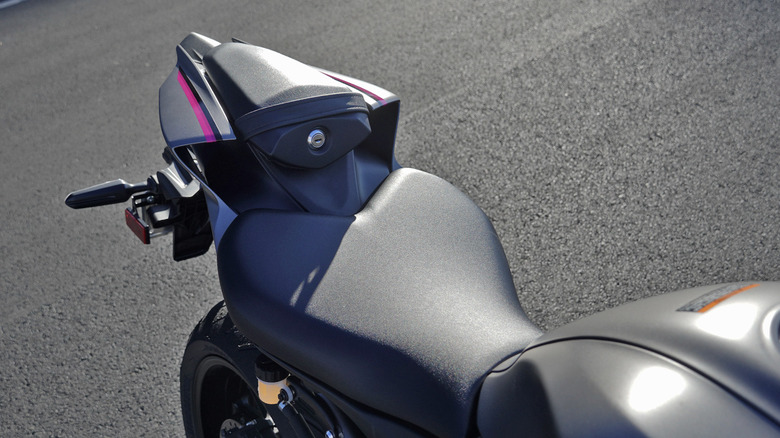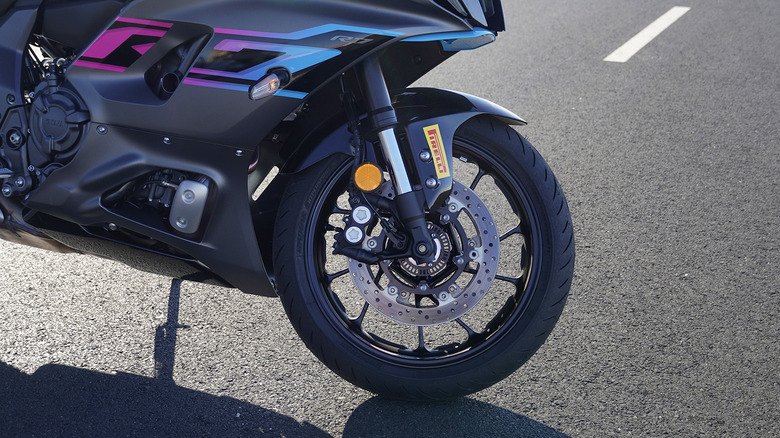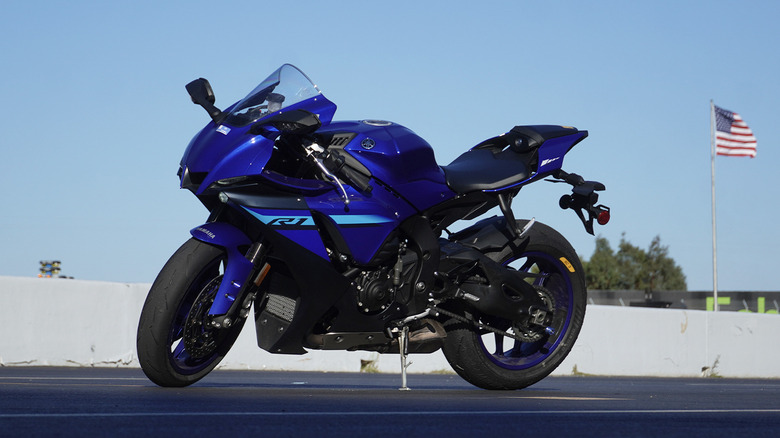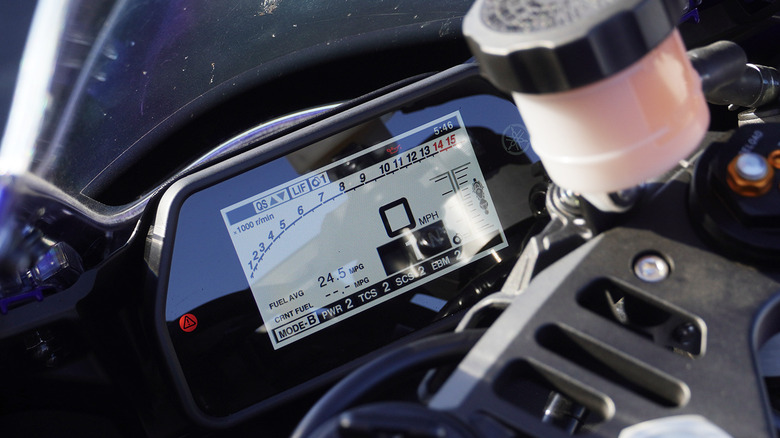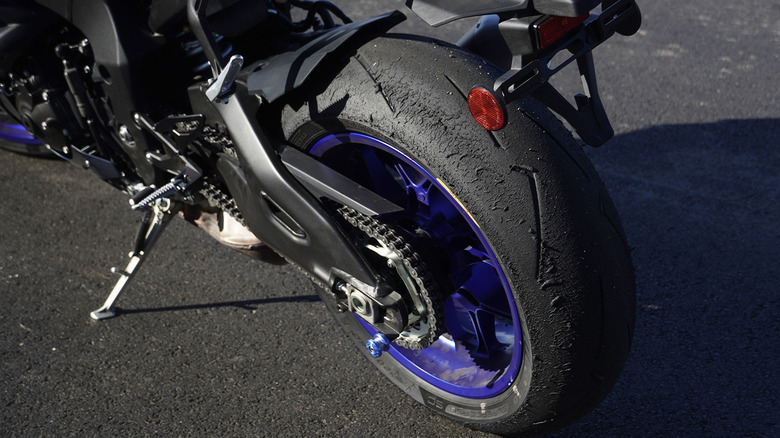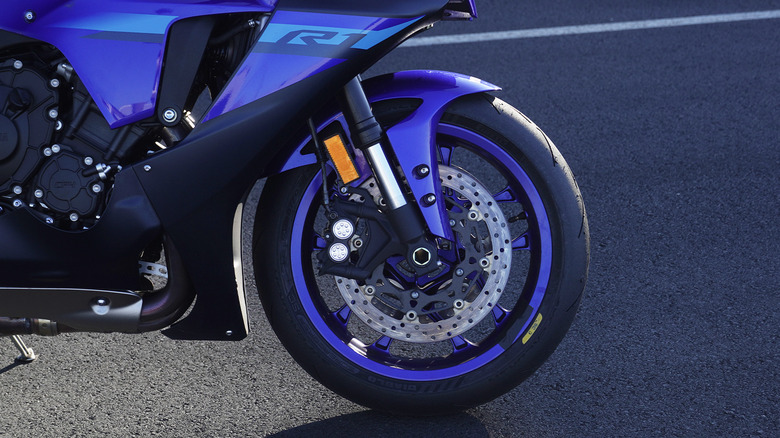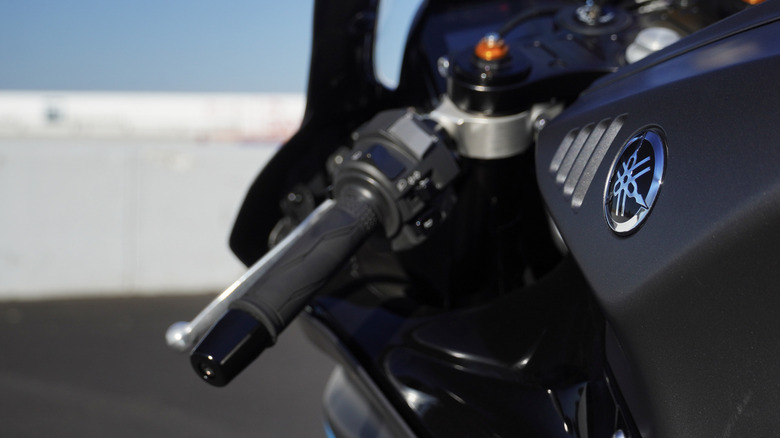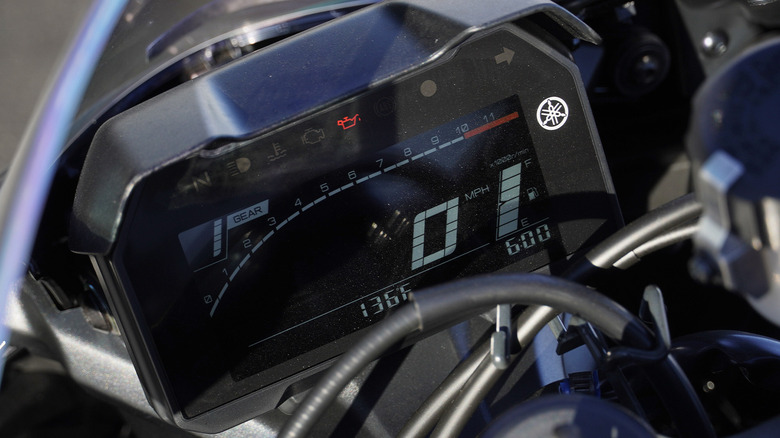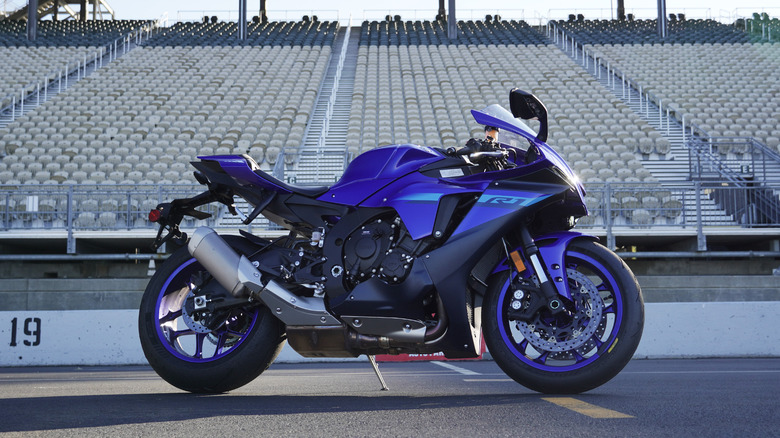Yamaha R1 Vs R7 Buyers Guide: Which Should You Pick Up For Track Day Fun?
The YZF-R7 has now been on the motorcycle market since 2022, as a next-gen middleweight that arrived with big shoes to fill after Yamaha discontinued R6 production in 2020. Modern emissions restraints come into play for the R7 in a big way, since despite the increased displacement from the R6's 599cc inline-four to a 689cc parallel twin, dropping two cylinders results in around 65 horsepower and 45 lb-ft of torque. For context, the R6 possessed nearly double that output, at 116 horsepower, and yet the R7's wet weight still increased by around 10%, too.
Still, the R7 delivers slick styling and updated tech, and most riders should know that starting with an underpowered bike always helps to improve technique and skills that transfer over to bigger, more powerful motorcycles equally. Already, though, many R7 owners have concluded that in addition to the power drop and weight bump, the R7's suspension stands out as the bike's most limiting factor. Track rats in particular began almost immediately swapping on components from the outgoing R6, a known quantity with proven performance, to bolster the R7's stability and speed.
I recently spent a full day at Sonoma Raceway riding an R7 back to back with an R1, while battling a recent repaving job that resulted in terrible track conditions for motorbikes, to suss out whether it's worth buying an R7 at $9,199 or whether serious riders should simply bite the bullet and go all-out for an R1 at about double the price.
Small, nimble, and modern: the YZF-R7
Even parked on a kickstand next to an R1, the R7 looks compact and nimble. The low-ish seat and high-ish handlebars—for a sport bike—also provide a surprisingly comfortable cockpit, even for my long arms and legs. The R7 certainly wins the style competition, too, with a smooth angularity that pops especially well in a flat gunmetal gray with Miami Vice neon art deco graphics.
Climbing aboard, I first scooched around on the narrow saddle, then turned my attention to the modern digital gauge screen. The readout requires little in the way of mental adjustment, providing clear information even on a bright, sunny day. Part of the simplicity comes down to a lack of more advanced features common on other modern bikes—a quickshifter or adjustable ride modes, for example—but I also found myself surprised that the little parallel twin only revs to 10,000 RPM.
I quickly figured that range slots this Japanese sport bike into a more similar category as an Aprilia RS 660 rather than a Kawasaki ZX-4RR or Honda CBR600RR, which makes sense given the cylinder count.
A torquey parallel twin
Still, the little engine provided plenty of low-end torque as I feathered out the cable clutch and pulled away from the pits. At 414 pounds wet, I found enough power to cruise up Sonoma's famous hill at turn 1 before blending into the racing line, warming up the bike's fluids and my own body simultaneously. But shortcomings started to emerge immediately as I built up to track pace. Namely, in the suspension and electronics department.
The lack of any adjustable ride modes, including ABS and traction control, simply bedevils comprehension these days. But even the simple mechanical suspension struggled over Sonoma's unfortunately asphalt patching job, which tends to create unpredictable ripples and smooth sections right where motorcycles reach maximum lean angle on the ideal line. The fickle textures seriously challenged the R7, and my own skills, as I felt the front and rear tires squirming and sliding at the worst possible times.
Testing at Sonoma Raceway
I ended up choosing sub-par lines to avoid most of the worst sections, but also put a ton of weight into my knee pucks at times while catching slides. Not pleasant, to say the least, though I found a small point of pride in the fact that I needed new pucks by mid-morning without needing a new bike—both due to my femur length and knee angles on the low seat, but also because I consistently got low enough on a sketchy bike and track regardless.
Scuttling around Sonoma, putting that much pressure on my knees probably only slowed me down, so I started to focus on better lines to hold more speed despite longer, wider arcs at a more upright angle. Doing so pushed me out into dusty areas of track, though, where other riders rarely traveled. But I wound up carrying more speed because I needed to make fewer corrections, which let me more fully dip into braking, too.
Pace and poise on a challenging circuit
The R7 lacks the power to get up to serious pace at Sonoma, but the brakes still reined in any late braking fairly well. A Brembo master cylinder for the fronts probably helped, giving me enough modulation with just my middle finger to set the rear tire a little loose as the forks compressed through a cushiony stroke to put pressure on the front tire. Using one finger helped me blip the throttle through downshifts more easily, a plus given the lack of a quickshifter.
Then I let up a bit and leaned into corners, trusting the little 689cc engine's maintenance throttle more than most bikes on track because the modulation from off to on produced little in the way of lurch. Of course, that lack of grunt never created the gut-wrenching sensation of power-wheelie acceleration up and out of corners that I love, so my focus turned to holding and carrying speed despite the squiggle and squirming through corners.
Liter-bike gut-punch for the win
No track day feels complete without the gut-punch of a full liter bike, so I pulled into the pits and swapped onto an R1 for a few stints. Not an R1M, unfortunately, but rather a bone-stock bike. That means ride modes and individual selection of traction control, engine braking, and ABS settings, but still the R1 essentially remains unchanged since 2015 and could probably use a generational leap in the near future.
I expected the jump up in power to blow my mind, since the R1's 998cc inline-four pumps out 200 horsepower at 13,500 RPM on the way to a 14,000-RPM redline. But then I immediately stalled twice pulling out of the pits, to the great amusement of everyone who pointed and laughed. Later, I checked and learned how much the R1 clearly prioritizes high-end output, which clearly comes at the expense of low-end torque. And in fact, with a peak of "just" 85 lb-ft, the R1 might triple an R7's horsepower but less than doubles the parallel twin's torque rating.
A quick couple of stalls
Interesting, yet track riding always depends more on the higher end of the rev range anyhow, so I just needed to get away from my spectators and start lapping. Mentally, I rationalized the embarrassment with surprise that the R1 also uses a cable clutch, rather than a hydraulic setup as on my Ducati, but such justifications only go so far as a means of assuaging the fragile male ego.
The best solution for letting go of mental hangups? The mandatory distraction factor of pushing hard on a seriously powerful motorcycle. Stepping up from the R7 to the R1 requires complete focus, as I started sliding back and forth on the saddle, needing to put more weight on the footpegs, catching small wheelies even with wheelie control activating. Ripping through gears to keep the inline-four spun up, I found the quickshifter only works well up in the higher RPMs, but bogs noticeably at the lower end—and especially when I tried to upshift at anything other than full throttle.
Easily finding speed on the R1
Hitting full throttle required braking harder and harder, then as my comfort level grew, later and later. The quickshifter's auto blip downshift helped, and the R1's brakes provide enough initial bite to produce some rear tire skating (the 448-pound wet weight might help). Diving deeper into corners revealed a strange tailing off of braking ability, though, sort of the opposite of an Aprilia RSV4 Factory, which required more pressure at first, then less as I went deeper into the brake lever travel.
More importantly than the straightline power and braking, though, the R1's stability through corners regardless of surface conditions simply left the R7 in both the literal and metaphorical dust. Fully adjustable KYB suspension (though not electronically controlled) plus magnesium wheels that somehow come standard, combined to let me forget the patches and just ride the ideal race line at the lowest lean angles, then rocket back out on the straights with perfect aplomb.
Doing so never required me to lay too much puck down, either, thanks to slightly less aggressive geometry than I expected. The R1's slim waist and tank design let me hug in a knee fairly well, while the front-to-rear distribution of those 448 pounds responded well to countersteering input without requiring me to sacrifice my focus on screwdriver hand positioning despite the additional force of braking and accelerating much more significantly.
Comfort and confidence on a budget
Technically, I visited Sonoma and rode the Yamahas to test new gear from Alpinestars. I wore a mid-level Missile Ward suit and a pair of more ergonomically comfortable SMX-6 v3 boots that seem ideal for the lower speeds on a R7-class bike. In fact, I now wear the SMX-6 v3 any time I pull on full leathers for public roads, which translates well to mid-tier bikes since I typically lack the insanity of a 200-horsepower liter bike in my garage.
The whole point of investing in motorcycle gear is to increase safety and comfort simultaneously, so that confidence and skill can develop without requiring more serious financial expenditure. But in that regard, I believe the R7 rides a little sketchier when pushing hard, while the R1's stability results in more safety.
So do you buy the R1 or the R7?
At least, maybe it's safer. Because then again, honing my riding abilities on track has worked at an exponential rate versus street riding, and the more budget-friendly R7 revealed every littlest of my muscle twitches at the wrong times, therefore requiring more attention to finesse, not to mention more courage. The lack of refinement, especially for track time, inevitably requires more correction of bad habits to avoid catastrophe.
So for anyone in the market debating the pros and cons of an R7 versus an R1, I'd argue the R7 will improve skill levels more quickly. Once you reach the limits of the R7, meanwhile, then the ability to swap on R6 suspension leads to the next level of your development as a rider (not to mention knowledge as a shadetree mechanic, upgrading the bike at home in the name of keeping costs low).
Home mechanics in the making
For anyone who plans to pay a mechanic to install upgrades, though, maybe stepping up to an R1 from the jump starts to make more sense. The thrill of speed certainly becomes intoxicating surprisingly quickly, and braking harder while leaning longer on a heavier bike all lends to the ability to better manage fore and aft weight transfer. But what I learned more than anything on the R1 and R7 at Sonoma is that suspension is more important on track than all-out power—focusing on how to carry speed through corners, more than straightline acceleration.
On the other hand, an R7 might seem cheap compared to an R1, but versus others in the similar class, less so. My best friend the Aprilia RS 660, for example, pumps 95 horsepower out of a slightly smaller parallel twin, weighs less, and allows for surprisingly simple fine-tuning of riding modes.
A used R1 is the sweet spot, maybe
At my current level of experience, the prospect of a lightly used R1 looks more appealing (even if I truly want an R1M): find one with a few thousand miles ridden by a responsible adult, from any time in the past few years since the bike received little in the way of updates since 2015. The full liter bike experience might overwhelm newcomers or beginners to track riding, though, who would benefit most from the experience of learning on a bike like the R7.
Then there's the idea of buying a new R7, and learning enough about wrenching while installing forks and a rear damper from an R6. This path might cost a few thousand more bucks over 18 months or so, but along the way, can serve as a wonderful way of seeing where the motorcycle passion takes you. Before shelling out for a track-only R6 Race, that is, which Yamaha still sells in non-road-legal form.
